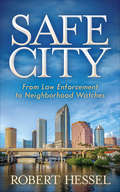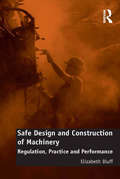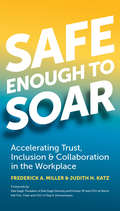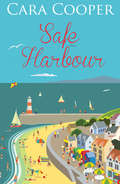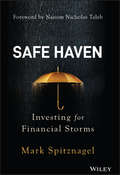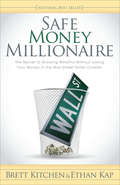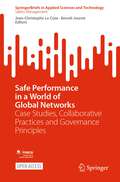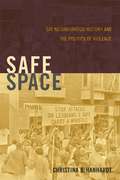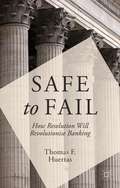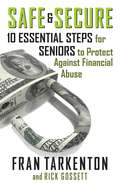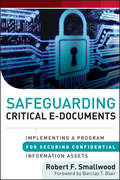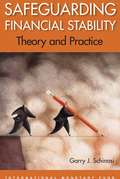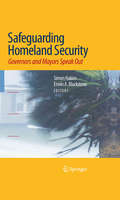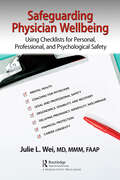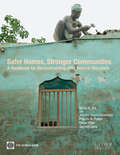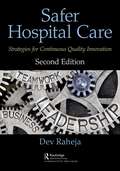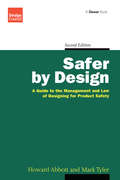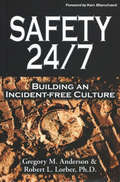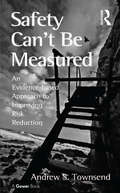- Table View
- List View
Safe City: From Law Enforcement to Neighborhood Watches
by Robert HesselA timely books that details the concerted effort and integration of new technology it takes to make communities safer for everyone. It&’s a basic human right to feel and be safe in your community—where you live, work, and play. But, few people know or understand everything it takes to make this possible, including making high-tech solutions available to local law enforcement and first responders. From fire departments detecting fires within seconds with thermal imaging to police departments detecting gunfire immediately through gunshot detection sensors, technology continues to evolve daily. Even surveillance cameras have taken great strides from the grainy images of years past, and just one camera can make a difference (read about how police identified the Boston Marathon bombers through a department store&’s video camera inside!). Safe City teaches the public how to harden targets and protect their homes, businesses, communities, themselves, and their loved ones. It takes a community effort to help reduce and prevent crime, and Safe City answers the questions people have along with pointing out many more that should be asked. &“As someone who is politically active, and involved with urban development, this book is like a playbook for mayors, city council, and county commissioners.&”—Topher Morrison, author of The Profitable CEO and managing director of Key Person of Influence &“Provides a fact-filled insight into community policing . . . This a good read that delivers a solid understanding of the &‘how and why&’ of the future of community policing in America.&” —Retired Deputy Chief Metro Detroit Police Department
Safe Design and Construction of Machinery: Regulation, Practice and Performance
by Elizabeth BluffThe origin of this book is the compelling evidence that a high proportion of machinery-related deaths and injuries are attributable to genuine and serious risks originating within machine design and construction. This trend continues despite significant legal obligations, notably the European regulatory regime giving effect to the Machinery Directive (among others), and a substantial body of specialist knowledge originating in the disciplines of human factors and safety engineering. Grounded in empirical research with machinery manufacturers, this book aims to elucidate the factors and processes shaping firms’ performance for machinery safety, and considers their compatibility with legal obligations. Through a unique blending of rich empirical data coupled with safety, human factors, socio-legal and learning scholarship, the book provides both a nuanced account of firms’ performance for machinery safety, and makes conceptual and theoretical contributions to understanding and explaining their performance. Specifically, the book elucidates the role of knowledge and motivational factors - and how these are constituted - in shaping firms’ performance. It reveals the multiple state and non-state influences that create plural responses among manufacturing firms, which typically operate in supply chains and networks, and often globally. These insights provide the foundations to enhance regulatory design, and the book’s conclusion recommends some innovative directions for regulatory interventions to sustain the safe design and construction of machinery.
Safe Enough to Soar: Accelerating Trust, Inclusion, & Collaboration in the Workplace
by Judith H. Katz Frederick A. MillerBestselling authors and renowned diversity consultants Fred Miller and Judith Katz bring their long-awaited new book that shows any manager or member of a team how to create safe environments for everyone in their company. Some organizations pay a great deal of attention to ensuring the physical safety of their team members, but do the team members feel safe enough to speak up and raise tough concerns? Share bold and still-in-formation ideas? In this book, bestselling authors and inclusion experts Frederick A. Miller and Judith H. Katz introduce the concept of "interaction safety" and demonstrate how it can help create a work environment of trust, inclusion, and collaboration. Interaction safety encourages reasonable risk-taking and inspires every individual to be brave enough to reach for higher goals and more ambitious possibilities. When interaction safety exists, people know they will not be penalized, ostracized, demoted, made small, discounted, or shunned because of their thoughts, contributions, and conversations. Individuals feel encouraged, empowered, and can achieve more together than they would alone. Miller and Katz provide a four-level model for assessing and increasing the interaction safety in organizations, illustrated by short scenarios taken from real-life situations. They offer concrete actions team members, leaders, and organizations can take to build and maintain a productive, collaborative, and innovative environment in which people do their best work individually and collectively.When interaction safety is a way of life, the energy people used to spend walking on eggshells, trying to get their ideas heard, navigating minefields, or avoiding those they distrust can instead be put towards doing their best work and winning bigger for the organization. With a culture of openness and true collaboration, both the organization and individuals can soar!
Safe Food Act: A Consumer Group's Perspective
by Carin-Isabel Knoop Ray A. Goldberg Harold F. Hogan Jr.The Center for Science in the Public Interest is taking a position on creating a new safety leadership vehicle in the U.S. government. How should it plead its cause? What are the position merits and faults?
Safe Harbour
by Cara CooperA British romance by Cara Cooper.Cassandra Waverley is thrilled with her beautiful harbourside restaurant. She's escaped a stressful job in the city and a personal meltdown which haunts her still. Just when she is relishing her seaside haven, dark, brooding Adam Hawthorne turns up, taking an unhealthy interest in her property and turning her world upside down. He's a serious threat, both to her business and to her heart. The more she learns about him the more she realises he's a man with mysteries in his own past. Throw in a wayward younger sister and a rescue kitten who needs a home and Cassandra has her work cut out for her. Will she ever find a safe harbour, and a love that will endure?
Safe Harbour
by Cara CooperA British romance by Cara Cooper.Cassandra Waverley is thrilled with her beautiful harbourside restaurant. She's escaped a stressful job in the city and a personal meltdown which haunts her still. Just when she is relishing her seaside haven, dark, brooding Adam Hawthorne turns up, taking an unhealthy interest in her property and turning her world upside down. He's a serious threat, both to her business and to her heart. The more she learns about him the more she realises he's a man with mysteries in his own past. Throw in a wayward younger sister and a rescue kitten who needs a home and Cassandra has her work cut out for her. Will she ever find a safe harbour, and a love that will endure?
Safe Haven: Investing for Financial Storms
by Mark SpitznagelWhat is a safe haven? What role should they play in an investment portfolio? Do we use them only to seek shelter until the passing of financial storms? Or are they something more? Contrary to everything we know from modern financial theory, can higher returns actually come as a result of lowering risk? In Safe Haven, hedge fund manager Mark Spitznagel—one of the top practitioners of safe haven investing and portfolio risk mitigation in the world—answers these questions and more. Investors who heed the message in this book will never look at risk mitigation the same way again.
Safe Money Millionaire: The Secret to Growing Wealthy Without Losing Your Money In the Wall Street Roller Coaster
by Brett Kitchen Ethan KapIt’s time to say goodbye to the tired financial advice that has lost Americans Trillions of dollars in wealth. Contrary to what the Wall Street propaganda machine would have you believe….there’s no need to risk your hard earned money in order to grow wealthy. Within these pages you’ll learn the “Safe Money Millionaire” plan that can grow your wealth safely and protect you against the ravages of unknown future tax liabilities. Plus you’ll learn how to “Finance Yourself To Wealth” and reduce or eliminate the amount of interest you pay to banks and credit card companies. Here’s What You’ll Discover: How you could add $800,000 to over 1 Million dollars to your family’s wealth with a simple, predictable plan, without risk in the market, Why financial guru’s and Wall Street don’t promote this 100 Year old secret to safe money wealth, A safe place to shelter your hard earn retirement savings from future market crashes, The shocking truth about rates of return, and why a higher ‘rate of return’ doesn’t mean you are getting wealthier! How to “Finance Yourself To Wealth” and reduce or eliminate the interest you pay to banks and credit card companies, What a Bank Robber named Willy Sutton teaches about who is really out to confiscate your wealth, The secrets most people never know about the giant tax bite you could pay on your 401(k) savings. (You could end up paying 5 times more in taxes than you’ll save!), Financial Guru’s Exposed: Suze Orman practice what she preaches? Jim “Mad Money” Cramer’s advice make people money? Why John D. Rockefeller said “If I had to give any advice, it would be to keep out of Wall Street,” and How fee’s could be ravaging your 401(k) and Mutual Funds costing you thousands of dollars and years of retirement.
Safe Performance in a World of Global Networks: Case Studies, Collaborative Practices and Governance Principles (SpringerBriefs in Applied Sciences and Technology)
by Benoît Journé Jean-Christophe Le CozeThis open access book provides an analytical and critical outlook, by leading scholars, of the impact of various trends in the quality of collaboration and resulting safety outcomes that arise from the evolution of traditional integrated production within a single firm into a complex web of partnerships and supply chains. In the face of increasing fragmentation within industrial production and the associated rise in the complexity of inter-organizational communication and transaction, this book analyses causal factors such as cost pressures, globalization of demand, increasingly flexible resource allocation and work organization, changes in legal liability and the possibilities afforded by information technology. Various case studies focus on the effects of crossing boundaries between organizations, between different trades and professions and between countries, assessing the effect of variations in regulatory structures and national cultures. Furthermore, they illustrate the wide range of organizational forms to be found in high-hazard industries today and the impact, potential or real, of the variety of forms of partnership on safety and well-being at work. The contributors assess the effect of out-sourcing and of various forms of partnership and governance on safety at work and how they can be made to support the prevention of major accident hazards.
Safe Space: Gay Neighborhood History and the Politics of Violence
by Christina B. HanhardtWinner, 2014 Lambda Literary Award in LGBT Studies Since the 1970s, a key goal of lesbian and gay activists has been protection against street violence, especially in gay neighborhoods. During the same time, policymakers and private developers declared the containment of urban violence to be a top priority. In this important book, Christina B. Hanhardt examines how LGBT calls for "safe space" have been shaped by broader public safety initiatives that have sought solutions in policing and privatization and have had devastating effects along race and class lines. Drawing on extensive archival and ethnographic research in New York City and San Francisco, Hanhardt traces the entwined histories of LGBT activism, urban development, and U. S. policy in relation to poverty and crime over the past fifty years. She highlights the formation of a mainstream LGBT movement, as well as the very different trajectories followed by radical LGBT and queer grassroots organizations. Placing LGBT activism in the context of shifting liberal and neoliberal policies, Safe Space is a groundbreaking exploration of the contradictory legacies of the LGBT struggle for safety in the city.
Safe To Fail
by Thomas F. HuertasBanks are entering a new environment. Regulation and supervision are becoming tougher, so that banks will be less likely to fail. If a bank does fail, bail-in rather than bail-out will be the new resolution regime, so that investors, not taxpayers, bear loss. Safe to Fail sums up the challenges that banks will face and how they can meet them.
Safe and Secure: 10 Essential Steps for Seniors to Protect Against Financial Abuse
by Fran Tarkenton Rick GossettThieves and scammers are on the prowl for easy targets who have significant exposed assets—and if you're a senior citizen who saved for retirement, you may be the perfect mark. Fran Tarkenton, the NFL Hall of Fame quarterback who became a succesful entrepreneur, has partnered with certified public accountant and financial executive Rick Gossett to present this practical, up-to-date guide to scam-proofing your savings during your golden years. Safe & Secure will give you ten specific actions steps that will turn you from an “easy” target into a “hard” target. A well-prepared senior who understands the potential for financial abuse and has taken the precautions recommended in this book is more than likely to remain safe and secure through a long and comfortable retirement. “As our country gracefully ages, we need to make sure to do all we can to protect the elderly—from their health, to their mind, to their finances. Once again, a man we all trust and respect has stepped forward and answered the call. With his simple and effective ways of explaining important concepts, legend Fran Tarkenton is doing his part to keep the elderly safe, drawing on his successful career both on and off the football field.” —SANJAY GUPTA, Assistant Professor of Neurosurgery at Emory University and CNN Chief Medical Correspondent “From helping us all recognize that we’re potential targets to providing easily comprehensible and implementable solutions, Fran Tarkenton and Rick Gossett have provided an extremely invaluable and indispensable resource. Elder nancial abuse will remain a major concern as our population ages. The tools presented here can help everyone be prepared and less likely to be a victim.” —THOMAS E. PRICE, MD, former Secretary of Health and Human Services and former member of US House of Representatives
Safe to Say at Prudential Financial
by Amy C. Edmondson Corey HajimThe CEO initiated a cultural change process at Prudential Financial to support a major business reorientation. Prudential, historically a privately held ("mutual") insurance company, went public in 2001. The cultural change was intended to prepare the organization to be a publicly traded financial services firm in which speaking up was encouraged at all levels of the organization.
SafeBlend Fracturing
by Frank V. Cespedes Benson P. Shapiro Alisa ZaloshThe CEO of SafeBlend Technologies must set a price for the company's environmentally friendly fracturing fluid additive. The firm is negotiating a new contract with its biggest client, Bristol Natural Gas. For the past two years, SafeBlend has been the sole provider of additives to Bristol due to aggressive negotiation and limited competition. New competitors are entering the market, and the CEO believes one competitor is prepared to offer Bristol a chemical-free additive for 50% less per gallon than SafeBlend. Anticipating lower bids from competitors, he considers reducing the price in the new contract to maintain the relationship with Bristol-despite the impact on revenue. However, the competition may not be able to supply enough additive to meet all of Bristol's needs, so he also considers the impact of setting a more competitive and profitable price that assumes losing only a portion of Bristol's business.
SafeGraph: Selling Data as a Service
by Ramana Nanda Allison M. Ciechanover Abhishek NagarajSet in January 2021, the CEO of SafeGraph, a four-year-old startup that sold Data as a Service, looked to the future. His aim was to become the most trusted source for data about a physical place. The company provided points of interest (POI) and foot traffic data on nearly 7 million businesses in the U.S. and Canada from a variety of providers, then labelled attributes of the data such as the brand affiliation and how long consumers remained at the site. The company sold this data to nearly one hundred customers in advertising tech, retail, and financial services. Clients such as Verizon, Sysco, and Goldman Sachs used it to better understand rapidly changing patterns of consumer behavior. At the outset of the COVID-19 pandemic, the company offered free access to its data through the COVID-19 Data Consortium to government agencies to help them understand pandemic behavior and make policy decisions. Nearly a year into the health crisis and with a vaccine rolling out, SafeGraph needed to decide how to evolve the COVID-19 Data Consortium. Perhaps the data offered for free should soon be converted to a paid model, albeit on a subsidized basis? More broadly, how should the team prioritize the government sector into its enterprise customer segment mix and how would this impact the business model and pricing?
Safeguarding Critical E-Documents: Implementing a Program for Securing Confidential Information Assets
by Robert F. SmallwoodPractical, step-by-step guidance for corporations, universities and government agencies to protect and secure confidential documents and business records Managers and public officials are looking for technology and information governance solutions to "information leakage" in an understandable, concise format. Safeguarding Critical E-Documents provides a road map for corporations, governments, financial services firms, hospitals, law firms, universities and other organizations to safeguard their internal electronic documents and private communications. Provides practical, step-by-step guidance on protecting sensitive and confidential documents—even if they leave the organization electronically or on portable devices Presents a blueprint for corporations, governments, financial services firms, hospitals, law firms, universities and other organizations to safeguard internal electronic documents and private communications Offers a concise format for securing your organizations from information leakage In light of the recent WikiLeaks revelations, governments and businesses have heightened awareness of the vulnerability of confidential internal documents and communications. Timely and relevant, Safeguarding Critical E-Documents shows how to keep internal documents from getting into the wrong hands and weakening your competitive position, or possible damaging your organization's reputation and leading to costly investigations.
Safeguarding Financial Stability
by International Monetary FundA report from the International Monetary Fund.
Safeguarding Homeland Security
by Erwin A. Blackstone Simon HakimThis book brings together the technological and managerial innovations suggested and applied by the nation's leading governors and mayors in their own words. It includes models for public-private partnerships to improve preparation for, response and recovery from major natural disasters and terrorist attacks. These leaders in innovation point out how the 9/11 communication problems that contributed to the catastrophe have been addressed, including the use of volunteer agencies and volunteers to supplement governmental efforts, which is a recurring theme of the book. The book makes specific recommendations of services usually provided by public emergency agencies that are private in nature and could be shed by government while often being provided by the private sector. The book further suggests public services that are under the responsibility of governments but could be delivered more efficiently by contracting them out under competitive conditions and highlights incentives for greater involvement of the private sector in the delivery of emergency services.
Safeguarding Physician Wellbeing: Using Checklists for Personal, Professional, and Psychological Safety
by Julie L. WeiThe United States is facing a worsening epidemic of physician burnout with unprecedented numbers of them leaving the workforce and practice of clinical medicine across all career stages. The prevalence of physician burnout has accelerated through COVID-19, resulting in an anticipated serious national shortage of physicians within the current decade amidst an increased proportion of aging and unhealthy population. The critical shortage of physicians coupled with an unhealthy physician workforce results in longer wait times for access, continued increased healthcare costs, decreased quality of care, and worsening patient experience. Despite increasing media coverage, published data, and identification of system-based factors that erode physician wellbeing, no standardized systematic solution has been implemented across hospitals, health systems, or a variety of employment models or practice settings for any or all doctors regardless of whether they are primary care, medical, or surgical subspecialists. Effective solutions to mitigate physician burnout, protect current working physicians, and keep them from leaving medicine require a SHIFT and a more individualized approach. Many proposed academic models address system-based factors, but such solutions depend greatly on those who employ doctors. Executive leadership in charge of healthcare systems are often challenged by physician burnout and their desired autonomy, against the need for standardization of care delivery to improve quality and decrease cost. Physician productivity measures continue to be based on data samples of physician compensation surveys supplied by companies like Sullivan Cotter or Medical Group Management Association (MGMA). Such benchmarks are commonly used but data may not reflect specific realities for any organizations nor the rapid changes in the landscape of US healthcare amidst mergers, acquisitions, consolidation, and shifts in employment models from insurance and online retail giants and private equity. This book uses a "checklist" approach to empower any medical student, resident, fellow, or practicing physician to create and experience psychological, personal, and professional safety and wellbeing. Not only can individual physicians choose and use these checklists themselves, but those who live with, love, and cherish one or more physicians in their families and/or lives can use this book to understand physician realities and their risks.
Safer Homes, Stronger Communities: A Handbook for Reconstructing After Natural Disasters
by Priscilla M. Phelps Daniel Pittet Stephen Sena Jennifer Duyne Barenstein Abhas K. JhaBest practices in post-disaster housing and community reconstruction are constantly evolving. The frequency and severity of disasters are increasing and technology is changing how reconstruction is done. Reconstruction projects must increasingly focus on the need to reduce future risks by ensuring that what is rebuilt is safer and more disaster-resilient than what was there before. The expanding role of communities in managing community reconstruction, with financial and technical assistance from government, is another way reconstruction is changing. 'Safer Homes, Stronger Communities' is a handbook that gives policy makers and project managers the information they need to plan and carry out housing and community reconstruction projects that empower communities affected by disasters and that reduce their vulnerability to future disasters. The handbook includes nearly 100 case studies collected from global experts with recent experience in housing reconstruction that illustrate how the policies and practical approaches recommended in the handbook have been used on the ground. It also includes links to extensive technical information on the topics covered by the handbook and is complemented by a Web site for practitioners in the field (http://www.housingreconstruction.org). Designed to provide immediate guidance in post-disaster reconstruction settings, 'Safer Homes, Stronger Communities' is a vital resource for policy makers and project managers, and for all practitioners involved in post-disaster housing and community reconstruction and disaster risk management.
Safer Hospital Care: Strategies for Continuous Quality Innovation, 2nd Edition
by Dev RahejaAccording to the National Patient Safety Foundation, about 440,000 deaths from hospital mistakes are expected in 2018. These mistakes are preventable, but the number of deaths has been increasing for the last two decades instead of decreasing. This book describes how to prevent deaths at very low cost and get very high return on investment (ROI). The unique feature of this book is that it teaches the tools of innovation that anyone can master. It teaches healthcare staff how to manage innovation efficiently and quickly, because each patient life is critical. This second edition points out why the present methods are ineffective and shows how to find elegant solutions that are simple, comprehensive, and produce high return on investments. The second edition contains all updated material with the addition of a new chapter on systems engineering for robust improvements, a practice that has been applied in most high-risk industries, such as aerospace, defense, and NASA, for years. It aims at redesigning systems to make sure right things, right coordination and right integration happens in healthcare systems.
Safer by Design: A Guide to the Management and Law of Designing for Product Safety
by Mark Tyler Howard AbbottProduct safety begins with design or formulation whether it is for a complex engineering product or a simple household article. Those who suffer damage from a design defect can win compensation without having to prove negligence. Manufacturers, suppliers and importers can all be responsible for ensuring that their products are safe. To help protect them against prosecution, customer dissatisfaction and commercial loss requires a programme of risk reduction, which begins with the management of design. Design and product development require a balanced approach to the new realities of the legal situation, both for companies and individual designers. Part One reviews the strategy needed to manage design in the fresh legal climate and includes guidance on techniques that can be used. Part Two is a jargon-free guide through the difficult area of international product liability law. It has been entirely rewritten to reflect the many recent changes to influence European law and a designer's personal liability. Part Three brings home vividly the physical, legal and commercial risks of product defects and demonstrates ways in which they could be prevented. There are over 20 real life, fascinating and instructive case histories, many of them new, ranging from exploding office chairs to ro-ro ferries and from washing powder to aircraft. Safer by Design is exceptional in providing management and risk assessment advice, coupled with legal guidance and actual practical lessons.
SaferTaxi: Connecting Taxis and Passengers in South America
by Peter A. Coles Benjamin EdelmanSaferTaxi, a taxi booking service in South America must develop its mobilization strategy; that is, it must attract enough passengers and drivers to make its service worthwhile for all. Drivers hesitate to pay for SaferTaxi's smartphones and service unless these will deliver passenger bookings -- and passengers have no reason to sign up unless drivers are available. Meanwhile, regulators question the permissibility of online taxi booking in light of regulatory requirements, and some existing taxi booking vendors feel threatened by SaferTaxi's efforts to enter the market. As SaferTaxi attempts to satisfy these diverse constituents, international competition looms. What should SaferTaxi's founders do next?
Safety 24/7: Building An Incident Free Culture
by Robert L. Lorber Gregory Mark AndersonIn the United States more than 5,000 workplace fatalities and 1,500,000 lost time injuries occur each year. What’s more, according to the United Nations’ International Labour Organization, over two million lives are lost each year to job-related accidents and illnesses, plus more than 268 million lost time accidents occur globally. Behavior based safety is crucial to the success of every company no matter how large or small. Whether reading in the board room or on the front line, Safety 24/7 helps address all of these questions in a simple-to-read format that is sure to make a difference in both your professional and personal life. Safety 24/7 was written to show you how these incidents can be dramatically reduced, even eliminated, and help build a culture of safety.
Safety Can't Be Measured: An Evidence-based Approach to Improving Risk Reduction
by Andrew S. TownsendThe British Prime Minister has avowed to ’kill off the health and safety culture’ which he described as ’a monster’. Nonetheless, industries face ever increasing public expectation and legislative pressure to improve safety when, actually, rates of safety improvement have slowed to a standstill. In Safety Can't Be Measured, Andrew Townsend suggests the main reason for the stagnation of safety improvement is the failure to recognise the evolution in accident causation and to evolve with it. He severely criticises some aspects of current day management of occupational safety and contends that everyone is trying to continuously improve something in which improvement cannot be measured, so the received wisdom underpinning safety management and regulation is not evidence-based and much of it is misguided. What is measured is the absence of safety - through incidents, injuries and the occurrence of ill health. We cannot continue to justify these ways of doing things, and claiming success by association, without admitting there might be other explanations. In this series of short chapters, occupational health and safety is put in context by demystifying the research, regulation and management of health and safety. Using evidence, Townsend challenges orthodox dogma by demonstrating that currently unused data could help deduce how safety really works, and thus support alternative thought processes from which new approaches to risk reduction and safety management could emerge.
